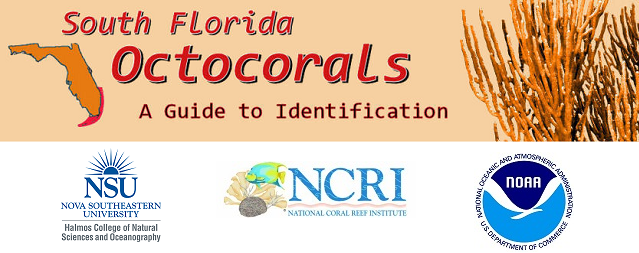Interactive Identification Guide to South Florida Octocorals
How to use this guide Character Guide Interactive Key
Full Species List References list
We have lots of pictures in the Interactive Guide, please give it a minute or two to load. If you cannot view the Interactive Key above, please click here for an interactive PDF version of the map. You must have Adobe Reader or Foxit installed in order to view this file. You must fully download and save this file and open it in Adobe Reader or Foxit in order to view it.
Octocorals ...
- are the sea fans, sea plumes, soft corals, sea pens, sea rods, gorgonians and their relatives;
- belong to the major group, or phylum, of the Animal Kingdom that also includes the stony corals, sea anemones, black corals, jellyfishes, hydroids, and Portuguese man o' war;
- like other members of the phylum, have cells that produce microscopic stinging capsules called cnidae (“NYE-dee”) for feeding and defense, although none cause a painful reaction in humans;
- grow as colonies of small, interconnected, bag- or cup-like polyps, each composed of two tissue layers, with a mouth surrounded by a ring of tentacles, but no anus;
- have polyp anatomy arranged radially around the mouth like wheel spokes: eight pinnate tentacles and an interior digestive/circulatory chamber divided by eight partitions (thus, “octo” corals);
- like stony corals and anemones, lack the swimming medusa (“jellyfish”) stage found in many hydroids and fire coral;
- include many reef-dwellers that harbor symbiotic, single-celled dinoflagellate algae called zooxanthellae, that contribute to the colony’s nutrition;
- also include many deep-water species that feed chiefly on plankton;
- chiefly grow as either male or female colonies, although just under 10% of species are hermaphroditic;
- can in some cases reproduce asexually through fragments that can give rise to another colony;
- grow into a distinctive shape or vary depending upon factors such as currents and light;
- live exclusively in the ocean, cemented to the seafloor (although a few deep-sea species, and the sea pens, anchor in sand or mud, and their larvae can crawl or swim);
- range from small mats that encrust rocky seafloors to tree-like colonies 3 meters tall (a few species are small solitary polyps);
- number over 3,100 species;
- often require microscopic examination of skeletal structures for identification.
- are widespread, common and often dominant components of shallow-water marine communities on hard substrates, including reefs and rocky bottoms;
- number over sixty species;
- often outnumber stony coral species and may represent a greater percent of living biomass in local reef and rocky bottom habitats;
- are well known but in some cases are difficult to distinguish.
Browse the Interactive Identification Guide to South Florida Octocorals Collections:
Character and Character State Guides
South Florida Octocorals - All Images
South Florida Octocorals - Full Species List
- Antillogorgia acerosa
- Antillogorgia americana
- Antillogorgia bipinnata
- Antillogorgia elisabethae
- Antillogorgia kallos
- Antillogorgia rigida
- Briareum asbestinum
- Briareum polyanthes
- Carijoa riisei
- Ctenocella barbadensis
- Erythropodium caribaeorum
- Eunicea asperula
- Eunicea calyculata
- Eunicea clavigera
- Eunicea flexuosa
- Eunicea fusca
- Eunicea knighti
- Eunicea laciniata
- Eunicea laxispica
- Eunicea mammosa
- Eunicea pallida
- Eunicea palmeri
- Eunicea pinta
- Eunicea succinea
- Eunicea tayrona
- Eunicea tourneforti
- Gorgonia flabellum
- Gorgonia ventalina
- Iciligorgia schrammi
- Muricea elongata
- Muricea laxa
- Muricea muricata
- Muricea pendula
- Muricea pinnata
- Muriceopsis flavida
- Plexaura homomalla
- Plexaurella dichotoma
- Plexaurella fusifera
- Plexaurella grisea
- Plexaurella nutans
- Plexaurella pumila
- Pseudoplexaura crucis
- Pseudoplexaura flagellosa
- Pseudoplexaura porosa
- Pseudoplexaura wagenaari
- Pterogorgia anceps
- Pterogorgia citrina


